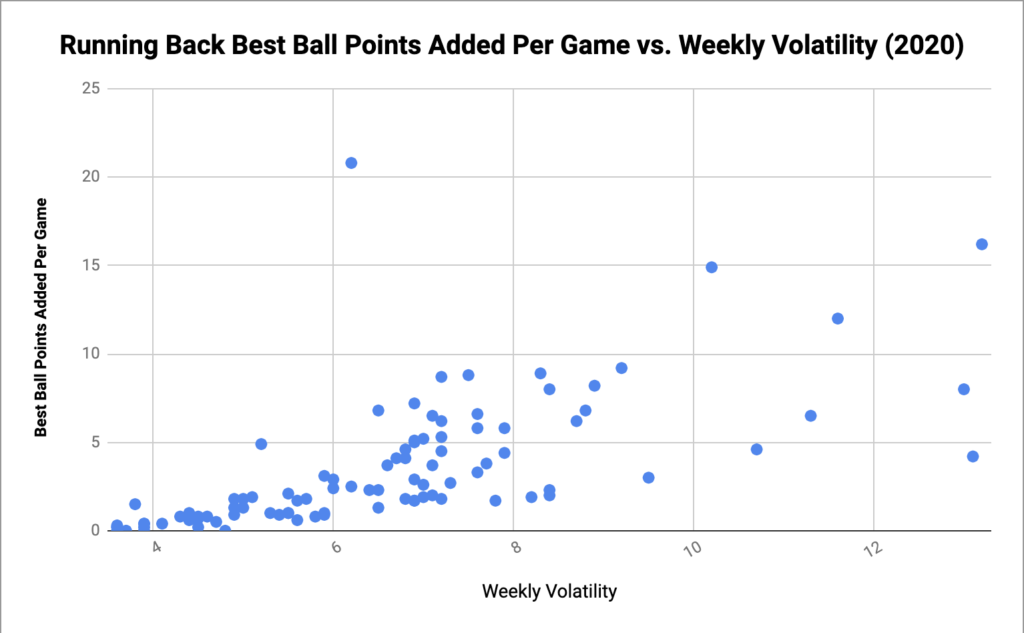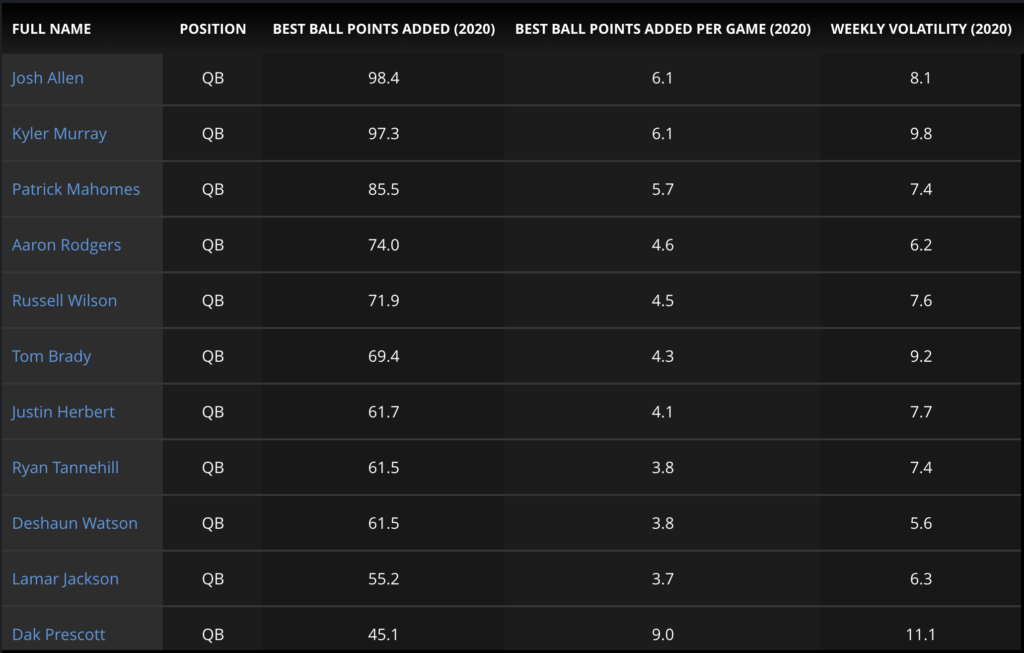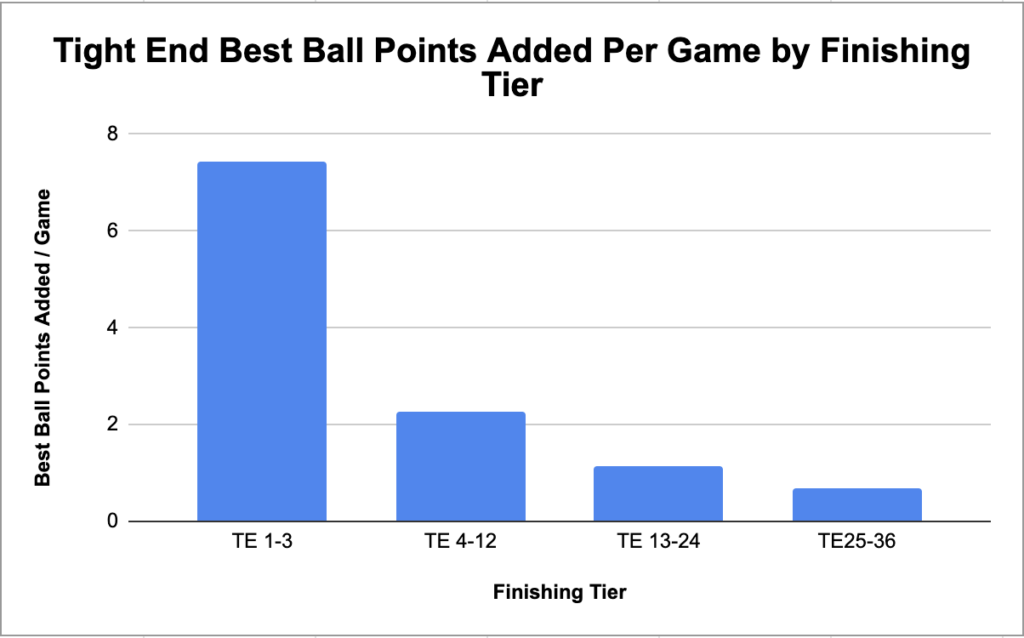Best ball is a newly popularized fantasy format, and familiarizing oneself with this new terrain can be intimidating. Metrics like win rate have been developed to help understand the idiosyncrasies of this particular version of fantasy football, but win rate can be skewed. A player can increase his win rate simply by being on winning teams. It doesn’t depict how useful a player was to best ball rosters as accurately as we would like. There existed a need for a metric that better quantified how much value a player accrued to best ball lineups, both weekly and over the course of the season.
Enter: Best Ball Points Added
What Is It?
Let’s start with the definition of the metric as listed on PlayerProfiler:
“In the best ball format formats, players must reach a weekly points threshold to qualify for the starting lineup each week. Total Best Ball Points Added aggregates a player’s total points scored above this quantified weekly threshold over the course of the season. This points system rewards weekly volatility, while discounting consistency.”
To put it in simpler terms, this metric quantifies the amount of points a player contributes to your team above what it would take to enter your starting lineup. Best Ball Points Added is a great evaluator of a player’s true contribution to teams.
How Does It Apply?
The main goal of best ball is for all of your players to achieve as many “boom weeks” as possible, thus creating maximum usability every week. This is why Fantasy Points Per Game is an inadequate measure of player value in this format. Taking weekly volatility and ceiling into account paints a clearer picture. Nick Chubb finished with 16.6 (No. 7) Half-PPR Fantasy Points per Game, while David Montgomery fell slightly behind pace at 15.9 (No. 9). In spite of this, Montgomery produced 8.9 (No. 6) Best Ball Points Added per Game compared to Chubb’s 8.8 (No. 7). This added value stemmed from Montgomery’s late season tirade and above average Weekly Volatility.
There does exist a level of correlation between volatility and Best Ball Points Added, but a high Weekly Volatility does not necessarily equate to best ball success. Players still require a meaningful role in order to provide any worthwhile production. Darwin Thompson had a 13.1 (No. 2) Weekly Volatility rating, but only contributed to rosters in his heroic Week 17 performance. Christian McCaffrey, however, performs at an elite level consistently enough to average 20.8 (No. 1) total Best Ball Points Added in an injury-marred season, while only having a 6.2 (No. 53) Weekly Volatility mark. Jeff Wilson is what happens when a player with massive volatility manages to carve out a role, earning 71.3 (No. 20) Best Ball Points Added on a 11.3 (No. 5) Weekly Volatility mark in 11 games.
Winners
We don’t give Antonio Brown enough credit for walking into Tampa Bay midseason and immediately making an impact. Brown finished with an 11.8 (No. 26) half-PPR Fantasy Points per Game average through Week 17. He displayed a low floor, but his ability to achieve usable weeks propelled him to 5.7 (No. 22) Best Ball Points Added per Game. In eight games, he provided more to best ball rosters than T.Y. Hilton, Jerry Jeudy, and others did over the whole season. Brown is currently being drafted as the WR45 on Underdog. Considering he now has an entire offseason to become more acclimated to the offense, there is a huge buy-low opportunity present.
Which Antonio Brown will we see in 2021? pic.twitter.com/6O5jzoeoEV
— RotoUnderworld (@rotounderworld) May 11, 2021
Conversely, Myles Gaskin was an unconventional winner. He blessed best ball drafters with 7.2 (No. 12) Best Ball Points Added per Game. Despite low volatility and only playing 10 games, Gaskin finished as a top 20 seasonal contributor at his position. He only hit the 20 fantasy point mark once (half-PPR), but finished as a top 24 RB in six of his 10 games. He was consistently usable and constantly accruing points to your lineup with his floor, and his lack of ceiling was made up for with a 30-point Week 16 performance.
Losers
Lamar Jackson was a surprising loser in best ball last season. His rushing ability gives him an elite floor that is desirable in standard formats, but his lack of ceiling held Jackson to 55.2 (No. 10) Best Ball Points Added. The Ravens face the league’s best Game Script and play and the league’s slowest pace. Jackson isn’t required to rack up the production that other quarterbacks like Justin Herbert and Dak Prescott, even with his rushing volume. If the team’s pace doesn’t increase, Jackson paying off his QB4 price could be a mirage for believers.
D.J. Moore was one of best ball’s biggest disappointments last season. While his seasonal half-PPR average of 11.9 (No. 21) Fantasy Points Per Game looks decent on the surface, his 71.2 (No. 28) Best Ball Points Added and 4.7 (No. 32) weekly average left share-holders wanting much moore (I couldn’t help myself) (editors note: I’ll allow it, but barely :>). He was the wrong kind of consistent. He scored less than 10 half-PPR points per game in seven out of 15 contests and only eclipsed 20 points once, a ceiling Peter Dinklage couldn’t even fit under. This is yet another warning sign for Moore for 2021.
Trends
One position where Best Ball Points Added shed light onto last season was tight end. It’s known that it’s a top-heavy position, but other tight ends were practically useless in comparison by the end of the season. Drafting Travis Kelce, who had 143.3 (No. 1) Best Ball Points Added, was more worthwhile than drafting two late round tight ends, even if they both finished in the top-12 in Best Ball Points Added. This tells us that the opportunity cost of passing up on one of the “Big Three” tight ends is higher than many analysts preach.
With only one year of data to work with, it’s not possible to find any concrete year-to-year trends yet. However, this metric opens up many avenues of research going forward. The more we learn about Best Ball Points Added, the better we’ll be able to analyze trends and predict outcomes. For now, we can use what we have to explore analytical relationships and begin to make hypotheses on what we’ll see in the coming years.









